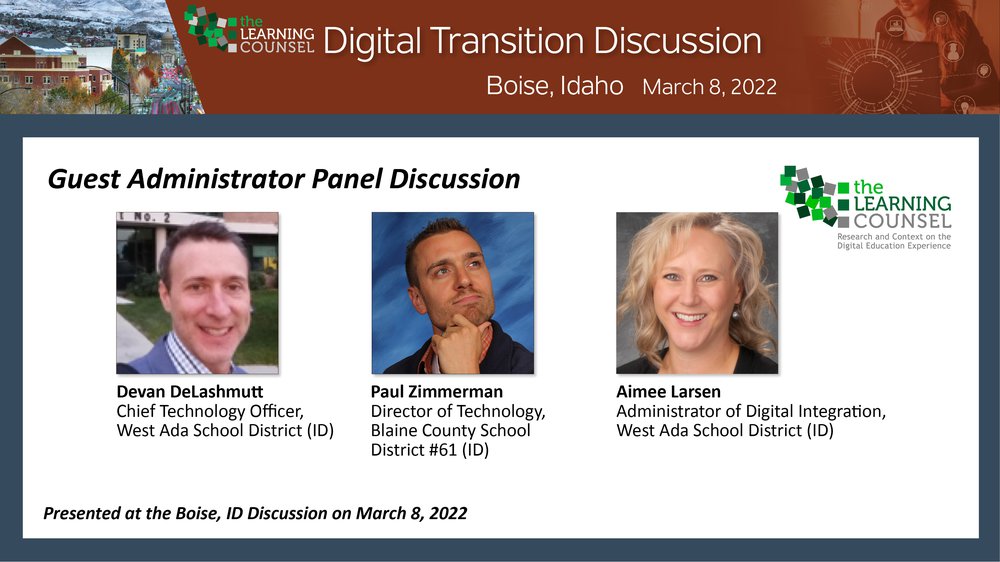Learning Counsel members love the Administrators’ Panel Discussions at our Digital Transition Discussions. They love the frankness, the no-holds-barred attitude, but mostly our members love the practicality of the panelists, and the fact that they get so many practical ideas they can use at home.
The Administrators Panel Discussion for Boise this year features Devan DeLashmutt, Chief Technology Officer at West Ada School District, Aimee Larsen, Administrator for Digital Integration Strategies for West Ada School District and Paul Zimmerman, Director of Technology for Blaine County School District
According to Aimee Larsen, “The purpose of my role at this point is to look at it through the ‘systemness’ of it. And to really look at technology through the instructional lens and ask, what's the end result? What do we want technology to help support? What's our objective? And then working backwards to really create an implementation plan.
“And that's for the hard part. Just working backwards to create the implementation. In fact, I think the biggest problem is the people, not the technology. The other part of it is the structural flexibility requirements, the total personalization. Being a large public school system, we face some obstacles in achieving that. And I don't think that's going to be quick work, in particular changing a traditional system, that's as rooted as we are. It's going to be incremental steps. And part of that is just the awareness that we've had to provide access to instruction for students in new situations. So, whether they're at home because of an extended illness, whether it was COVID-related or some other thing, we've now done the work to provide access where there was no access previously. That causes teachers to start rethinking the way they structure their instruction and activities. They're gathering evidence of students working. I think some of that work will lead us to a more personalized system.”
Technology Director Paul Zimmerman added, “I have 3,200 students and 500 staff (ish). So, a little different than you folks. We can be a little more nimble than what you guys are able to do. You know, I always joke that education changes at glacial pace, but my glacier is much, much smaller than yours. So, the things that you do operationally and the things you're doing on the instruction side, yes, we have operations to take care of, but also, because we can be flexible, we're able to look at where can we push the envelope. Where can we create momentum behind this project? Where can we use this technology or this tool to personalize something in a low-risk environment, because my low-risk environment's going to be 50 staff and 900 kids versus many, many more that you would have and allows us to push that envelope to try new ideas and try new things.
“We want to look at your workflows. We want to hear about how are you trying to do this? What is that thing over there? Or what have you not thought of that? That's our job. And we can be a part of affecting that personalization change by just listening to what it is. We have the keys to all of the technology. We know what it is.
“You have the keys to the instructional side. You have to work together. We have a similar set too, but with that, we can hear them and say, okay, personalization. But that's really complicated. Where students are involved, we have to be careful when we're like, ‘all right, everyone cheer for this great idea.’ But it's deeper because there are so many layers to get to that. And how do I drag all those layers with me? Even the layers I can control, like staff. I can drag them with me kicking and screaming sometimes, but I can't drag students with me. How can I create a system or a culture where the student will come along?”
CTO Devan DeLashmutt says, “I always feel like I need to be an expert in each area, but it's just not possible. And I'm not sure that teachers can be the expert in each one of those things either; they need to be the facilitator. And I think it's really hard to step away from that ‘I'm going to impart and give you that knowledge.’ I think technology can sometimes help with that. One of the powerful things that we've done in west Ada is we've always been very careful to remember that technology's a tool.
“It can be a powerful tool. Sometimes it's just not the right tool, and it just shouldn't even really to be part of the conversation. We really focused on the art of being a teacher and what the best practices are for teachers, some of those instructional skill sets that we really need teachers to learn and then trying to give them tools to actually help with their profession, as opposed to focusing on, ‘Hey, here's a tool that's going to help you do this.’ No, you're doing it for an instructional reason. Here are some tools and some ways you can do that. Some are technology-based and here are some other really great ways to do that.”
These administrators in Boise have one thing in common – they are brilliant, and brilliantly practical. All realize that the structure of technology – time and place – are changing. And they are figuring out ways to benefit the learner. And the best thing is, they are willing to share it all with you. Click on the panel discussion. You’ll find plenty of meat here, and a heapin’ helpin’ of good common sense to use in your own school or district.










